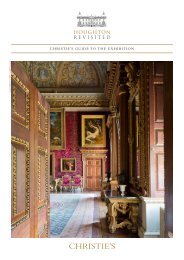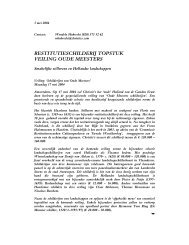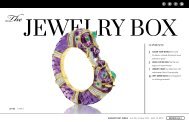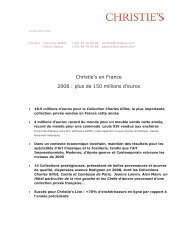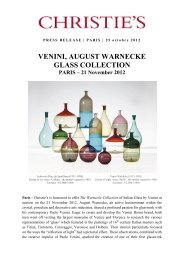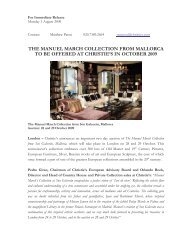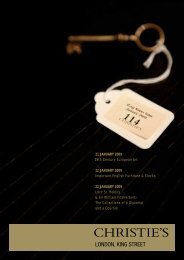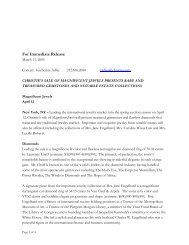THE EXCEPTIONAL SALE 2013 - Christie's
THE EXCEPTIONAL SALE 2013 - Christie's
THE EXCEPTIONAL SALE 2013 - Christie's
You also want an ePaper? Increase the reach of your titles
YUMPU automatically turns print PDFs into web optimized ePapers that Google loves.
William Beckford’s ‘sacred peach’ vases in rare ‘clair-de-lune’ porcelain<br />
and sculpted in relief with a sacred peach, are mounted with superbly<br />
modelled and beautifully chased mounts that can be attributed to Jean-<br />
Claude Chambellan Duplessis (d.1774), one of the most significant<br />
bronziers of the second half of the 18 th century (estimate: £400,000 –<br />
600,000, illustrated right). These sumptuously mounted vases in the late<br />
rococo style of circa 1760 represent a reaction to the fanciful asymmetry<br />
of early rococo, the Goût Pitoresque of the 1730s and 1740s. The vases,<br />
which are part of a very small group of similar vases, display the sacred<br />
peach, often used in Chinese art to symbolize immortality.<br />
CLOCKS<br />
Clocks in The Exceptional Sale include a Chinese paste-gem set ormolu and white marble ‘double<br />
gourd’ clock with swinging dial from the Guangzhou workshops, dating to the Qianlong period<br />
late 18 th century, which is one of only three recorded examples (estimate: £400,000 – 600,000,<br />
illustrated left). Both of the other two examples have been sold by Christie’s. The clock displays<br />
powerful symbolism: the double-gourd design is a potent symbol of fertility and good<br />
fortune; the inverted bat (pien-fu) signifies ‘blessings have arrived’; the character medallion a<br />
sign of ‘Longevity’; the Phoenix heads (feng or fenghuang) an emblem of the Empress and one<br />
of the four Guardians of the Universe.<br />
Further highlights include a musical table clock by James Cox (1723 - 1800),<br />
created in circa 1766, which was previously in the collection of King Farouk I<br />
(estimate: £450,000 – 650,000, illustrated right). Cox operated as a jeweller and<br />
goldsmith from his London premises at Shoe Lane, off Fleet Street. The principal<br />
component parts of the present clock appear throughout his oeuvre. Cox’s clock cases and<br />
necessaires comprise characteristic elements: boldly cast Rococo mounts, a variety of<br />
animals including lizards, elephants and lions to the feet and vase finials combined<br />
throughout with ‘caged’ specimen panels of polished agate. Christie’s has a long<br />
association with Cox, having sold his clocks from as early as 1772.<br />
PORTRAIT MINIATURES & OBJECTS OF VERTU<br />
An enamel plaque by Henry Bone, R.A. (1755 – 1834), the ‘Prince of<br />
Enamellers’, depicting Bacchus and Ariadne, is the artist’s largest and<br />
greatest work (estimate: £80,000 – 120,000, illustrated left). Henry<br />
Bone’s success as an enamellist was cemented when he was officially<br />
appointed Enamel Painter to the Prince of Wales, later Prince Regent,<br />
and to George III. Bacchus and Ariadne was purchased by George<br />
Bowles, an enthusiastic collector of Bone’s work, from the artist for<br />
2,200 guineas in 1811. George Bowles and the Prince of Wales shared<br />
the same taste for Bone’s work and they both owned copies of his<br />
enamel after Cantarini’s Holy Family with an Angel. The vast gilt-wood<br />
frame accompanying the ‘Bacchus and Ariadne’, elaborately carved<br />
with anthemion and scroll motifs and lion’s masks within wreaths, is reminiscent of the Carlton House taste<br />
that the Prince of Wales enjoyed.




